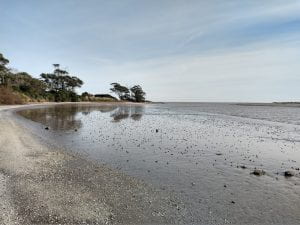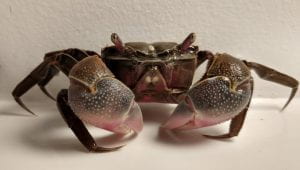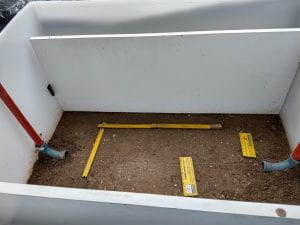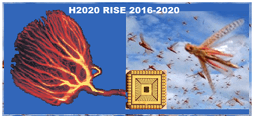Thomas Harper has just completed his MPhil (Neuroscience) in the Faculty of Medical Sciences at Newcastle University. He carried out his secondment with our STEP2DYNA project in 2018 – 2019 at the University of Buenos Aires in Argentina. During Thomas’ secondment, his work focused on Work Package 1: Collision detection visual neural systems modelling.

During my 7 month secondment to the University of Buenos Aires in Argentina, as part of my MPhil degree, I was tasked with helping to understand how the mud crab Neohelice granulata uses visual information to respond to approaching stimulus. My project comprised of two main areas: The optomotor response of crabs when different regions of the eyes had been painted; and whether binocular vision is involved in the newly described aggressive chasing behaviour exhibited by the crab.

Crab collection took place on narrow coastal inlets on the east coast of Argentina, approximately 400km south of Buenos Aires and collecting involved catching only males in large nets.
The 2 eyes of Neohelice are situated at the end of stalks giving a 360-degree visual field for each eye. Each eye can be split into 4 main areas, medial, lateral, anterior and posterior, which each have different sensitivities to motion. Painting each area of both eyes and placing the crab in an arena with 4 screens which produced a moving visual field made the crab turn. By covering the lateral and anterior regions reduced the response to the stimulus, showing these two areas are sensitive and important in the optomotor response.

These results linked nicely with findings from when one eye was painted to remove regions of potential binocular stereopsis. Crabs either had their left or right eye completely covered in paint, or both eyes uncovered and were placed in an arena where a moving dummy was presented. Depending on which area of the eye the dummy was sighted in caused different strategies of attack. A lunge attack was controlled by the anterior region and interceptions and fast running by the lateral. By analysing various measurements taken from each attack, overall the attacking behaviour is likely to be monocularly controlled, but could be using stereopsis when the dummy is close and in front of the crab.

During my secondment, I also prepared my abstract for the International Conference on Invertebrate Vision. I presented my poster ‘Is binocular stereopsis involved in trajectory control in the praying mantis strike?’ at the conference that occurred on the August 5th until August 12th 2019 at Bäckaskog Castle in Sweden.
This seven month secondment has taught me several new techniques including how to paint accurately, manipulate positioning of eye stalks, using computers in behavioural experiments and has helped me understand that in behavioural experiments how small factors may cause a large change in behaviour. By assisting other lab members it has helped to understand what mechanisms cause the behaviour and how different detectors and neurons serve different functions and can cause different behavioural responses. I feel it has helped me to improve my knowledge in this field and I hope to apply this knowledge to future projects and hopefully to a career in research in the future. Working in Argentina has helped me to build up a network of contacts, meeting others in the field and to learn about other work conducted, which will hopefully lead to new opportunities in my career.
